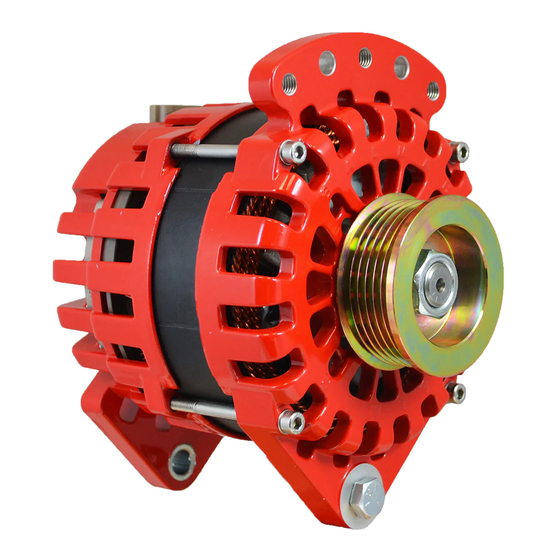Balmar 97EHD Series Panduan Instalasi dan Pengoperasian - Halaman 2
Jelajahi secara online atau unduh pdf Panduan Instalasi dan Pengoperasian untuk Generator Portabel Balmar 97EHD Series. Balmar 97EHD Series 20 halaman. Alternator

ALTERNATOR MOUNTING STYLES
Due to the large number of engine makers and engine models, Balmar cannot guaran-
tee a drop-in replacement for every application. We recommend installing the alternator
model that most closely matches your existing alternator. Your installer may have to adapt
the basic mounts to fit your needs. The majority of marine engines are equipped with one
of five alternator mounting styles. The following describes which alternator represents
each specific mounting style:
1. 60 & AT/XT-DF-Series (Dual Foot w/3.15" between mounting feet): Replaces most
small case alternators using a saddle style mount (eg., Hitachi, Lucas, Mitsubishi).
2. 621 & AT/XT-SF-Series (1"' Single Foot): Replaces most domestic styles using a sin-
gle 1" mounting foot (eg., Motorola, Prestolite). 621 is used without included spacer.
3. 621 & AT/XT-SF-Series (2" Single Foot): Replaces most domestic styles using a sin-
gle 2" mounting foot (eg., Delco). 621 is used with included spacer.
4. 94/94LY-Series (2" Single Foot and Dual Foot w/3.15" between mounting feet): See
case dimensions on our website at www.balmar.net to determine if your engine can
accommodate the large case alternator.
5. 95-Series (Dual "J-180" Foot w/4" between mounting feet): See case dimensions on
our website at www.balmar.net to verify if your engine compartment can accommo-
date the large case alternator.
6. 97, 97EHD & 98-Series (Dual "J-180" Foot w/4" between feet): Extra large case. See
case dimensions at www.balmar.net to determine if your engine can accommodate
an extra-large case alternator.
ALTERNATOR INSTALLATION ISSUES
1. While each alternator series may have some varied installation issues, the following
guidelines should be considered when installing any Balmar alternator:
2. Ensure, prior to installation, that the Balmar replacement alternator features a compat-
ible mounting configuration to the alternator being replaced. See information above.
3. Ensure that the replacement alternator is adequately sized to meet the demands of
your battery banks. As a rule of thumb, the alternator should be rated at 25-40% of
your house battery capacity, depending on the battery chemistry.
4. Ensure that the belt or belts driving the alternator are capable of handling the alterna-
tor's horsepower load. As a rule, a single 3/8" belt is capable of supporting up to 80
amps@12 volts, and a single 1/2" belt can support 100-amp@12-volts. Dual belts will
typically support alternator outputs of up to 300+ amps/12 volts. Driving an alternator
on an undersized belt will substantially increase the risk of belt slippage and prema-
ture belt failure. All 24-volt Balmar alternators require a minimum of dual 1/2" belts for
optimal performance. Balmar offers a wide selection of AltMount serpentine pulley kits
for marine diesel engines. Visit the Balmar website for more information and applica-
tion charts.
5. Balmar alternators are designed to be used in conjunction with external P-type regu-
lators. We recommend a Balmar multi-stage regulator for maximum charging per-
formance. Certain Balmar alternators designated as Smart Ready
stage internal regulator. Those alternators can be controlled by either the internal, or an
external voltage regulator. Please note that the internal regulator must be disabled when an external regulator is
being used.
6. All Balmar alternators except Case-Ground versions of the XT-Series are equipped with isolated grounding ter-
minals. Isolated ground alternator installations MUST include a dedicated cable connecting the alternator ground
terminal to system ground. The ground cable must be equal in size to the alternator's positive output cable, and
must meet the cable gauge requirements outlined in the cable size chart shown on Page 3.
7. Belt tension is a critical aspect of alternator performance. Monitor belt tension after every charge cycle for the first
several weeks of engine operation. We recommend a belt tensioning gauge for accurate deflection measurement.
Make belt tension monitoring and adjustment a part of regular maintenance.
feature a single-
®
Page
2
